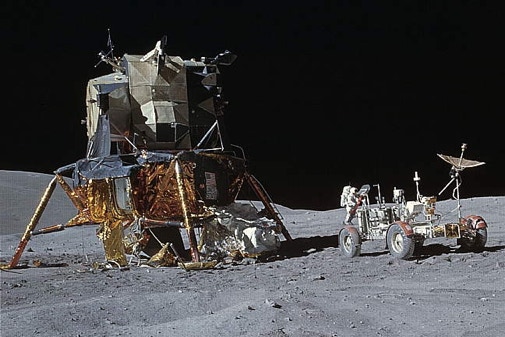

Exploring the Moon
A history of lunar discovery from the first
space probes to recent times
Driving on the Moon
With each successive mission astronauts spent longer on the Moon and explored a wider area. On the final three missions, astronauts were able to explore farther afield in a battery-powered Moon car, the Lunar Roving Vehicle (LRV), which was stored in the descent stage of the Lunar Module. Its wheels were made of steel wire, so there was no chance of punctures, and its top speed was 18 km/h (11 mile/h), achieved on the Apollo 17 mission.
Apollo 15’s landing site was the most spectacular of the entire series, next to the winding Hadley Rille at the foot of the Apennine mountains that border eastern Mare Imbrium. Astronauts David Scott and Jim Irwin drove to the edge of Hadley Rille from where they saw layers of lava in its walls. Evidently, the rille itself had been carved out by a later flow of lava. They also photographed what appeared to be layers of stratified rock on the flanks of an outcrop called Silver Spur next to Mount Hadley Delta to their southeast.
The most famous sample they collected was a white-coloured, crystalline rock dubbed the Genesis Rock by the media but catalogued more prosaically by NASA’s geologists as sample 15415. At first, this was thought to be a part of the original lunar crust, dating back some 4.6 billion years. Later analysis showed that it was about 4.1 billion years old, not as old as hoped but still predating the formation of Mare Imbrium.
Before leaving the surface, Scott performed an experiment to demonstrate Galileo Galilei’s finding that objects of different mass fall at the same rate. Galileo himself is supposed to have performed this experiment from the leaning Tower of Pisa using two balls of different weight. Scott used a hammer and a falcon’s feather (Falcon being the name of their Lunar Module). Without air resistance, the feather hit the surface at the same time as the hammer.
On the edge – the Apollo 15 Lunar Rover at Hadley rille
Driving on the Moon
Apollo 16 Lunar Module and Lunar Rover

